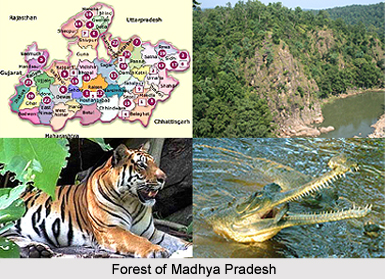 Forests of Madhya Pradesh cover around 95,221 sq kms area of the state. This area has been classified into `Reserved Forest`, `Protected Forest` and `Unclassified Forest`. Variability in climatic conditions brings about significant difference in the forest types of the state. There are four important types of forests namely Tropical Moist, Tropical Dry, Tropical Thorn, and Subtropical broadleaved Hill forests. The forest area can also be classified on the basis of composition of forest terrains. Based on composition, there are three important forest formations namely Teak forest, Sal forest and miscellaneous Forests. Bamboo bearing areas are widely distributed in the state of Madhya Pradesh. To obviate pressure on the natural forests, plantations have been undertaken in forest and non-forest areas to supplement the availability of fuel wood, small timber, fodder etc.
Forests of Madhya Pradesh cover around 95,221 sq kms area of the state. This area has been classified into `Reserved Forest`, `Protected Forest` and `Unclassified Forest`. Variability in climatic conditions brings about significant difference in the forest types of the state. There are four important types of forests namely Tropical Moist, Tropical Dry, Tropical Thorn, and Subtropical broadleaved Hill forests. The forest area can also be classified on the basis of composition of forest terrains. Based on composition, there are three important forest formations namely Teak forest, Sal forest and miscellaneous Forests. Bamboo bearing areas are widely distributed in the state of Madhya Pradesh. To obviate pressure on the natural forests, plantations have been undertaken in forest and non-forest areas to supplement the availability of fuel wood, small timber, fodder etc.
Central, southern and eastern parts of Madhya Pradesh are rich in forests, while western and northern parts are comparatively deficient in forest. Tropical Dry Deciduous Forests are mostly found in those areas having 25 to 75 cm rainfall. The general height of the trees found in these forests is around 8 metres to 20 metres. These forests are found in Sheopur district, Shivpuri district, Ratlam district, Mandsaur district, Tikamgarh district, Datia district, Gwalior district, Nimar district, etc. The major species found in these forests are Harra, Kekar, Babul, Tendu, Dhora, Haldu, Shisham, Sagon and Siris etc.
 The other major type of forest found in Madhya Pradesh is Tropical Deciduous Forest. These forests are found in the areas that receives 50 cm to 100 cm rainfall. These are economically viable and used for building material and furniture. Sagon, Shisham, Neem tree, Pipal, etc. are the major species found in this type of forest. The main regions where these forests are found are Sagar, Jabalpur, Chhindwara, Damoh, Chhatarpur district, Panna district, and Betul, Seoni, and Hoshangabad district. Next major type is that of Tropical Semi-Deciduous Forest. These forest types are found in the areas where 100 cm to 150 cm rainfall occurs. These are especially found in Mandla district, Balaghat district, Sindhi, and Shahdol district. The main species are Sal, Sagon, and Bamboo. In addition to that the other species found in the areas are Beeja, Dhaura, Jamun tree, Mahua, Seja, Harra, Kasai, and Tinsa. They are also called Monsoon forests.
The other major type of forest found in Madhya Pradesh is Tropical Deciduous Forest. These forests are found in the areas that receives 50 cm to 100 cm rainfall. These are economically viable and used for building material and furniture. Sagon, Shisham, Neem tree, Pipal, etc. are the major species found in this type of forest. The main regions where these forests are found are Sagar, Jabalpur, Chhindwara, Damoh, Chhatarpur district, Panna district, and Betul, Seoni, and Hoshangabad district. Next major type is that of Tropical Semi-Deciduous Forest. These forest types are found in the areas where 100 cm to 150 cm rainfall occurs. These are especially found in Mandla district, Balaghat district, Sindhi, and Shahdol district. The main species are Sal, Sagon, and Bamboo. In addition to that the other species found in the areas are Beeja, Dhaura, Jamun tree, Mahua, Seja, Harra, Kasai, and Tinsa. They are also called Monsoon forests.
Bushes and scrubs grow in very low rainfall area. The northwest part of the state, which is located in the boundary of Rajasthan, has the climatic conditions for such kind of species. The main bushes and trees are Babul, Nagfani, Mahua, etc. These bushes and scrubs characterise Shivpuri Forest Circle.
Further, the people of Madhya Pradesh are largely dependent on forests for their fuel and fodder needs. The drought prone livestock are also dependent on the forest for fodder and the total livestock population of the state is around 3.24 crores. Majority of the villages of the state are located near forest areas. Being away from the mainstream of development, most of the villagers are dependent on forests for their livelihood. In addition to these, there are a host of items like leaves, flowers, fruits, bark, seeds, roots etc. commonly referred to as non-wood forest products, which contribute significantly in socio-economic development of the rural communities.






